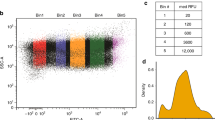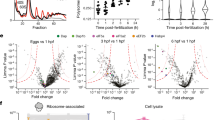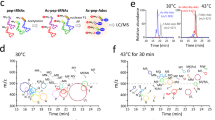Abstract
ONE of the best known examples of translational control in a eukaryotic system comes from studies on the mealworm, Tenebrio molitor, in which control of the synthesis of adult cuticular proteins at the translational level has been proposed1–7. From experiments using actinomycin D, it was concluded that the mRNAs for some of the adult cuticular proteins were synthesised by the first day of pupation1. To translate these mRNAs in vitro on first day polysomes, however, the tRNA and enzyme from 6 to 7 d pupae were required2–4. Ilan et al. gave further evidence for a leucine tRNA which seemed to be controlling the translation of the mRNAs and the synthesis of which seemd to be in the control of juvenile homone3–7. But our own studies of Tenebrio, reported here, lead us to question this translational control model.
This is a preview of subscription content, access via your institution
Access options
Subscribe to this journal
Receive 51 print issues and online access
$199.00 per year
only $3.90 per issue
Buy this article
- Purchase on Springer Link
- Instant access to full article PDF
Prices may be subject to local taxes which are calculated during checkout
Similar content being viewed by others
References
Ilan, J., Ilan, J., and Quastel, J. H., Biochem. J., 100, 441–447 (1966).
Ilan, J., J. biol. Chem., 243, 5859–5866 (1968).
Ilan, J., Cold Spring Harb. Symp. quant. Biol., 34, 787–791 (1969).
Ilan, J., Ilan, J., and Patel, N., J. biol. Chem., 245, 1275–1281 (1970).
Ilan, J., and Ilan, J., in The Physiology of Insecta (edit. by Rockstein, M.), 4, 355–422 (Academic, New York, 1974).
Ilan, J., Ilan, J., and Patel, N. G., in Insect Juvenile Hormones Chemistry and Action (edit. by Menn, J. J., and Beroza, M.), 43–68 (Academic, New York, 1972).
Ilan, J., and Ilan, J., Devl Biol., 42, 64–74, (1975).
White, B. N., Tener, G. M., Holden, J., and Suzuki, D. T., J. molec. Biol., 74, 635–651 (1973).
White, B. N., Tener, G. M., Holden, J., and Suzuki, D. T., Devl Biol., 33, 185–195 (1973).
Grigliatti, T. A., et al., Cold Spring Harb. Symp. quant. Biol., 38, 461–474 (1974).
Waters, L. D., and Novelli, D. D., in Methods in Enzymology (edit. by Grossman, L., and Moldave, K.), 20, 39–55 (1971).
Anderson, S. O., Chase, A. M., and Willis, J. H., Insect Biochem., 3, 171–180 (1973).
Hackman, R. H., and Goldberg, M., J. Insect Physiol., 2, 221–231 (1958).
Chase, A. M., Nature, 215, 1516–1517 (1967).
Chase, A. M., J. Insect Physiol., 16, 865–884 (1970).
Socha, R., and Sehnal, F., J. Insect Physiol., 18, 317–337 (1972).
Author information
Authors and Affiliations
Rights and permissions
About this article
Cite this article
LASSAM, N., LERER, H. & WHITE, B. Translational control in the mealworm, Tenebrio molitor. Nature 256, 734–735 (1975). https://doi.org/10.1038/256734a0
Received:
Accepted:
Issue Date:
DOI: https://doi.org/10.1038/256734a0
Comments
By submitting a comment you agree to abide by our Terms and Community Guidelines. If you find something abusive or that does not comply with our terms or guidelines please flag it as inappropriate.



